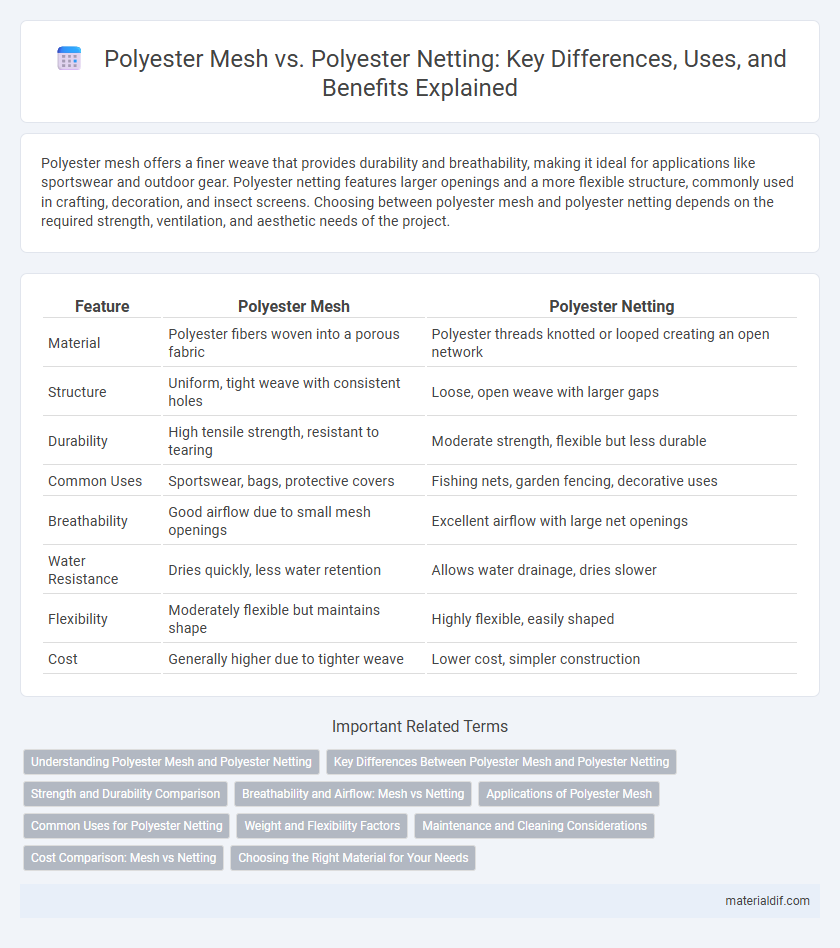Polyester mesh offers a finer weave that provides durability and breathability, making it ideal for applications like sportswear and outdoor gear. Polyester netting features larger openings and a more flexible structure, commonly used in crafting, decoration, and insect screens. Choosing between polyester mesh and polyester netting depends on the required strength, ventilation, and aesthetic needs of the project.
Table of Comparison
| Feature | Polyester Mesh | Polyester Netting |
|---|---|---|
| Material | Polyester fibers woven into a porous fabric | Polyester threads knotted or looped creating an open network |
| Structure | Uniform, tight weave with consistent holes | Loose, open weave with larger gaps |
| Durability | High tensile strength, resistant to tearing | Moderate strength, flexible but less durable |
| Common Uses | Sportswear, bags, protective covers | Fishing nets, garden fencing, decorative uses |
| Breathability | Good airflow due to small mesh openings | Excellent airflow with large net openings |
| Water Resistance | Dries quickly, less water retention | Allows water drainage, dries slower |
| Flexibility | Moderately flexible but maintains shape | Highly flexible, easily shaped |
| Cost | Generally higher due to tighter weave | Lower cost, simpler construction |
Understanding Polyester Mesh and Polyester Netting
Polyester mesh features a structured grid-like pattern with uniform openings, offering enhanced durability and breathability ideal for sportswear and outdoor gear. Polyester netting has a looser, more flexible weave suited for applications requiring lightweight and soft material, such as decorative crafts and insect screens. Understanding the distinct weave density and tensile strength differences between polyester mesh and netting aids in selecting the appropriate fabric for specific industrial or commercial uses.
Key Differences Between Polyester Mesh and Polyester Netting
Polyester mesh features a tighter weave with uniform, small holes, providing enhanced durability and filtration capabilities ideal for applications like sportswear and industrial filters. Polyester netting, characterized by larger, more open holes and a looser weave, offers greater breathability and flexibility, making it suitable for decorative uses and lightweight coverings. The primary differences lie in hole size, weave density, and application suitability, with mesh prioritizing strength and filtration, while netting emphasizes airflow and aesthetic appeal.
Strength and Durability Comparison
Polyester mesh and polyester netting both offer excellent strength and durability, but polyester mesh typically features a tighter weave that provides greater resistance to tearing and abrasion. Polyester mesh's dense construction makes it ideal for industrial applications requiring high tensile strength, while polyester netting's open weave allows for flexibility and breathability but may sacrifice some durability under heavy stress. The inherent UV resistance and moisture-wicking properties of polyester enhance the longevity of both fabrics, with mesh generally outperforming netting in demanding environments.
Breathability and Airflow: Mesh vs Netting
Polyester mesh features a more open weave structure, promoting superior breathability and airflow compared to polyester netting, which has a tighter weave that restricts air movement. The increased porosity of polyester mesh allows for enhanced ventilation, making it ideal for applications requiring quick drying and moisture wicking. In contrast, polyester netting provides more durability and protection but compromises air permeability, suitable for uses where airflow is less critical.
Applications of Polyester Mesh
Polyester mesh offers superior breathability and durability, making it ideal for applications such as sportswear, outdoor gear, and industrial filtration. Its lightweight yet strong structure supports effective airflow while providing resistance against wear and tear. Commonly used in backpacks, tents, and protective clothing, polyester mesh enhances comfort and performance where ventilation and strength are essential.
Common Uses for Polyester Netting
Polyester netting is commonly used in applications requiring durability and breathability, such as agricultural crop protection, sports equipment, and apparel linings. Its open-weave structure allows for excellent airflow, making it ideal for insect screens, protective covers, and lightweight bags. Unlike polyester mesh, which often features tighter patterns for filtration or reinforcement, polyester netting emphasizes flexibility and visibility while maintaining strength.
Weight and Flexibility Factors
Polyester mesh typically features a lighter weight and increased flexibility compared to polyester netting, making it ideal for applications requiring breathability and ease of movement. The denser weave of polyester netting provides greater durability and structural integrity but results in a heavier and less flexible material. Weight differences often influence material choice, with polyester mesh preferred in lightweight garments and sports gear, while netting suits industrial uses where sturdiness is essential.
Maintenance and Cleaning Considerations
Polyester mesh offers a tighter weave that resists dirt accumulation and requires minimal maintenance through regular brushing and occasional washing with mild detergent. Polyester netting, characterized by larger openings, allows easier debris removal but may need more frequent cleaning to prevent buildup in the gaps. Both materials are durable and quick-drying, making them suitable for outdoor use, but polyester mesh typically demands less intensive cleaning routines.
Cost Comparison: Mesh vs Netting
Polyester mesh typically costs more than polyester netting due to its tighter weave and increased durability, making it ideal for applications requiring strength and longevity. Polyester netting offers a more affordable option with a looser weave, suitable for lightweight uses such as gardening or sports. When budgeting, consider mesh for heavy-duty needs despite higher expense, while netting serves as a cost-efficient solution for less rigorous tasks.
Choosing the Right Material for Your Needs
Polyester mesh offers durability and breathability, making it ideal for applications requiring ventilation such as sportswear and outdoor gear. Polyester netting features a lighter, more flexible structure suited for decorative uses and lightweight containment like garden netting or craft projects. Selecting between polyester mesh and netting depends on the balance between strength, airflow, and flexibility needed for your specific application.
Polyester Mesh vs Polyester Netting Infographic

 materialdif.com
materialdif.com